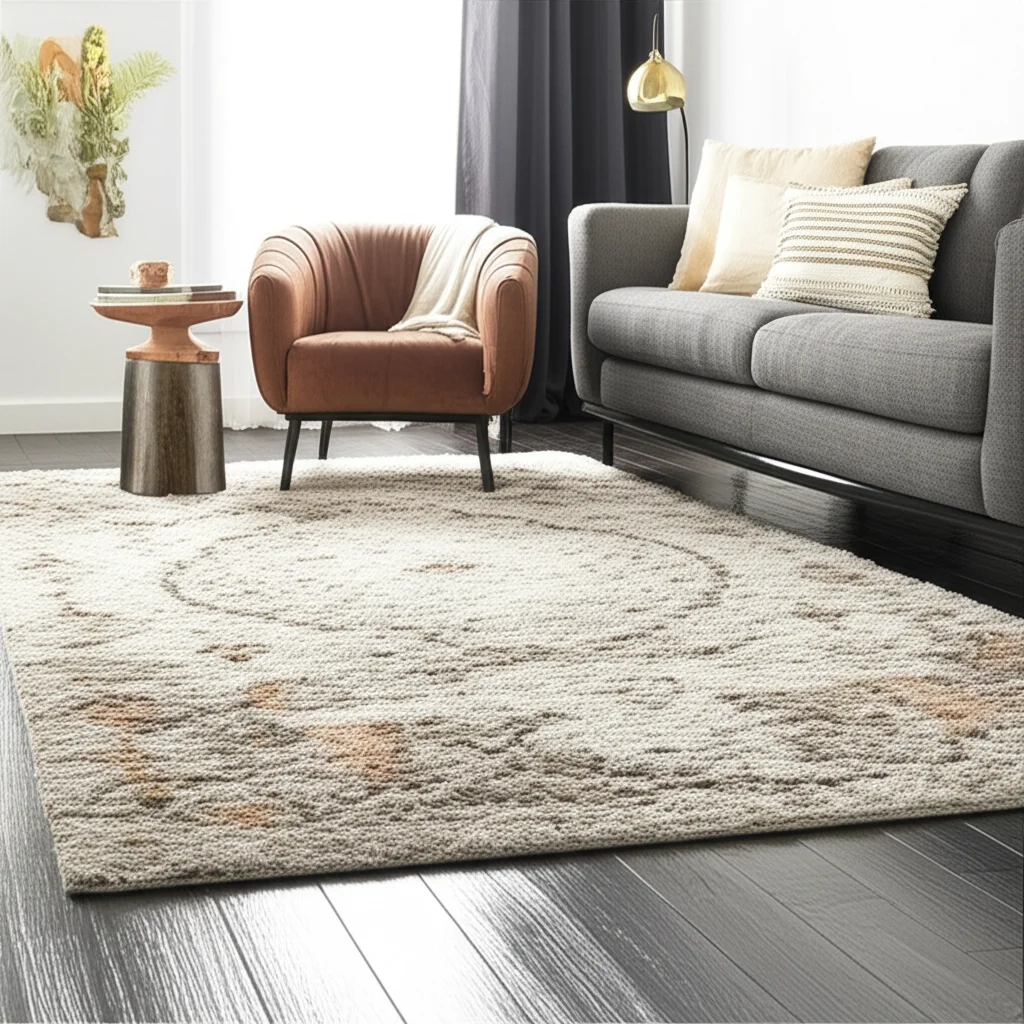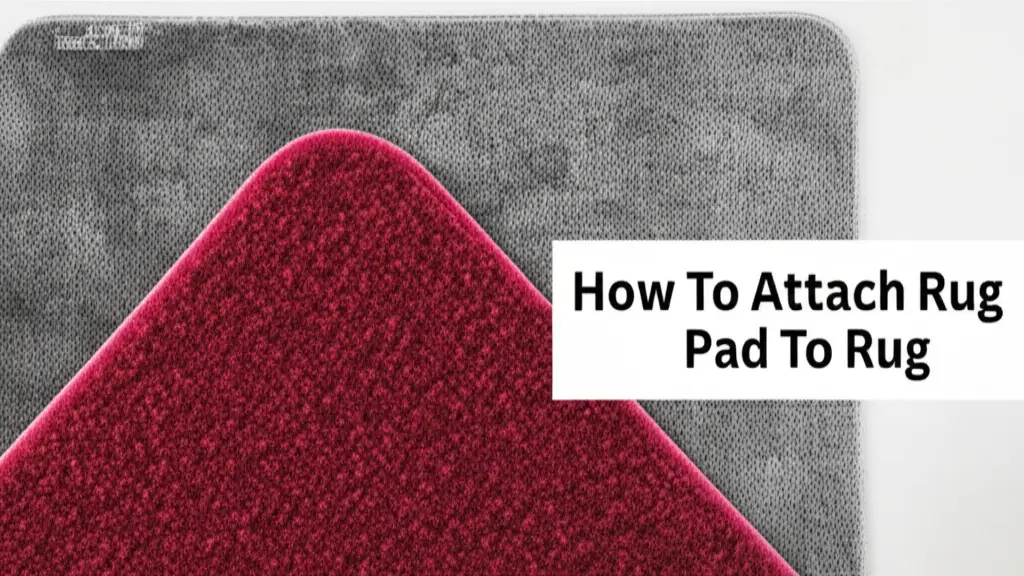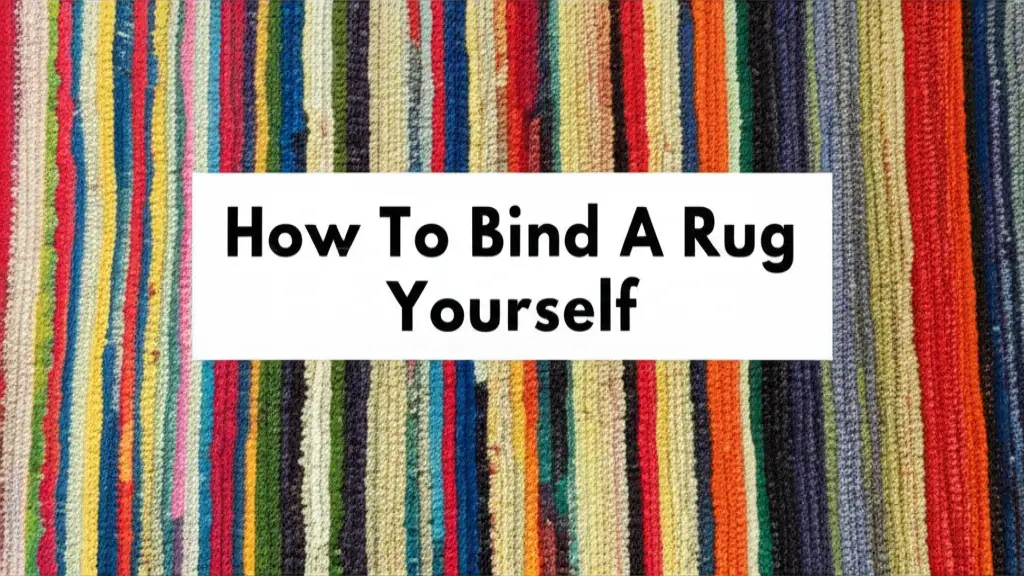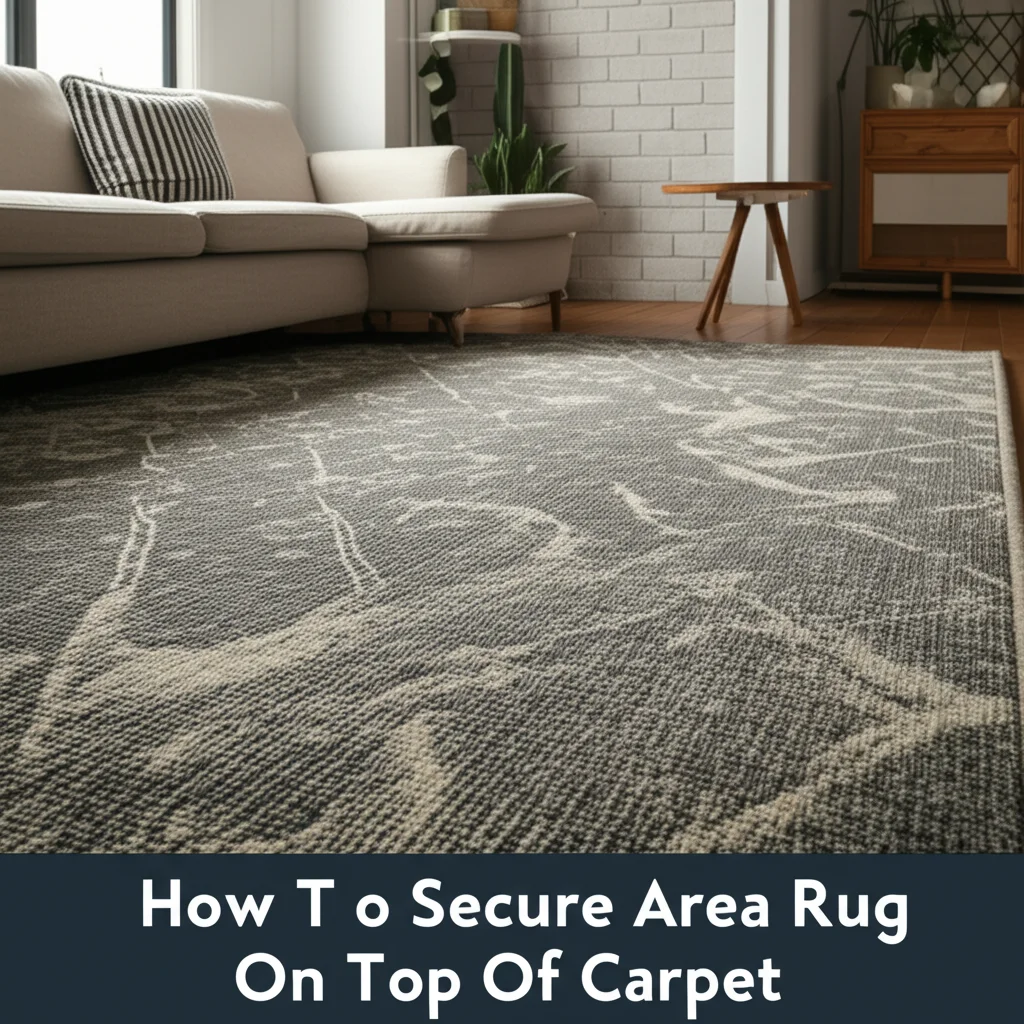· Todd Martin · Rugs · 11 min read
How To Anchor A Rug On Carpet

How to Anchor a Rug on Carpet: 7 Effective Methods that Work
Layering rugs over carpet adds depth, style, and personality to your home decor, but keeping them securely in place can be a frustrating challenge. If you’ve ever tripped over a bunched-up area rug or watched it slowly migrate across your carpet, you know the struggle is real.
Fortunately, there are several effective ways to anchor a rug on carpet that are both practical and affordable. In this comprehensive guide, we’ll explore proven methods to keep your rugs firmly in place, preventing slips, trips, and unsightly wrinkles.
Key Takeaways:
- Double-sided carpet tape is the most popular and effective solution for anchoring rugs
- Rug grippers and non-slip pads work well for medium to large area rugs
- Velcro and claw pins provide stronger anchoring for high-traffic areas
- Carpet-to-carpet tape is specifically designed for layering rugs over carpet
- Regular maintenance and proper rug selection can prevent slipping
Quick Answer:
To anchor a rug on carpet, use double-sided carpet tape along the edges and corners, place non-slip rug pads underneath, or apply rug grippers at the corners. For heavier rugs in high-traffic areas, consider carpet-to-carpet tape or specialized Velcro systems designed specifically for layering rugs over carpet.
Why Rugs Slip on Carpet and Why It Matters
Before diving into solutions, it’s important to understand why rugs move on carpet in the first place. Unlike hard surfaces where friction helps keep rugs in place, carpeted floors actually create less friction with rugs. The soft, fibrous nature of both surfaces allows them to slide against each other, especially when:
- The area experiences regular foot traffic
- Vacuum cleaners push and pull at the edges
- Pets run or play on the rugs
- Children play or wrestle on the floor
- The rug is lightweight or has a slick backing
This movement isn’t just annoying—it creates safety hazards. According to the National Floor Safety Institute, slips and falls account for over 1 million emergency room visits annually, with loose rugs and mats being a common culprit. Beyond safety concerns, constantly shifting rugs can damage your carpet fibers and make your living space look unkempt.
Method 1: Double-Sided Carpet Tape
Double-sided carpet tape is perhaps the most popular and straightforward solution for anchoring rugs on carpet. This specialized adhesive tape is designed to create a strong bond between the rug and the carpet underneath.
How to Apply Double-Sided Carpet Tape:
- Clean both the underside of your rug and the carpet surface to remove dust and debris
- Measure and cut strips of double-sided carpet tape to fit along the entire perimeter of your rug
- Apply the tape approximately 1-2 inches from the edge on the rug’s underside
- For larger rugs, add additional strips in a grid pattern across the central area
- Remove the protective backing from the tape
- Carefully position the rug on your carpet and press firmly to activate the adhesive
Double-sided carpet tape works best for lightweight to medium-weight rugs and provides a strong grip that can last for months. When selecting tape, look for options labeled “residue-free” to avoid damaging your carpet or rug when it’s time to remove or reposition.
For an even stronger hold in high-traffic areas, consider carpet-to-carpet tape, which is specifically designed for layering rugs over carpet.
Method 2: Non-Slip Rug Pads
Non-slip rug pads provide an excellent way to anchor rugs on carpet while adding cushioning and protection for both surfaces. Unlike traditional rug pads designed for hardwood floors, carpet-specific rug pads have specialized textures and materials that grip carpet fibers.
Benefits of Non-Slip Rug Pads:
- Prevents slipping and bunching without adhesives
- Adds cushioning and comfort underfoot
- Protects your carpet from wear and tear
- Extends the life of your area rug
- Easy to cut to size for custom fit
- Can be removed and repositioned as needed
When shopping for non-slip rug pads for carpeted surfaces, look for options with rubber or PVC backing that feature a textured surface designed to grip carpet fibers. Avoid felt-only pads, as these can actually make slipping worse on carpet.
For best results, choose a rug pad slightly smaller than your rug (approximately 1 inch shorter on all sides) to ensure the edges of your rug lay flat while still providing full coverage underneath. Regular vacuuming of both the rug and pad will help maintain their grip over time.
Method 3: Rug Grippers and Corner Anchors
For those who prefer a less permanent solution than tape but more targeted than full rug pads, rug grippers and corner anchors offer an excellent middle ground. These products typically use rubber, silicone, or other high-friction materials to keep rugs in place.
Types of Rug Grippers:
Corner Grippers: Small triangular or square pads that attach to the corners of your rug Edge Grippers: Longer strips that can be placed along the edges of your rug Disc Grippers: Round pads that can be placed strategically throughout larger rugs
Most rug grippers work through friction rather than adhesive, making them easy to remove and reposition. Simply place them under the corners and edges of your rug, and the grippy surface will catch on both the rug backing and carpet fibers.
For particularly stubborn rugs or high-traffic areas, consider combining grippers with another method like carpet-to-carpet tape for maximum security.
Method 4: Velcro Strips for Heavy-Duty Anchoring
When dealing with larger rugs or high-traffic areas, Velcro strips provide one of the strongest anchoring systems available. Specifically designed for carpet-to-rug applications, these systems use hook-and-loop technology to create a secure yet removable bond.
How to Install Velcro Strips:
- Purchase carpet-to-rug Velcro strips (available at most home improvement stores)
- Cut strips to fit the perimeter of your rug
- Attach the hook side (rougher texture) to your carpet using the provided adhesive
- Attach the loop side (softer texture) to the underside of your rug
- Press the rug firmly into place, ensuring the Velcro components align properly
The beauty of Velcro systems is that they allow you to easily remove your rug for cleaning while maintaining a precise placement when you put it back. This makes them ideal for dining rooms, where rugs need regular cleaning, or playrooms where consistent positioning is important.
For an even more comprehensive solution, consider learning how to attach a rug pad to your rug before using the Velcro system.
Method 5: Carpet Claw Pins for Permanent Installation
For situations where maximum security is required, carpet claw pins offer a semi-permanent solution. These small devices physically anchor your rug to the carpet underneath using small prongs that penetrate the rug backing and grip the carpet fibers.
Things to Consider with Carpet Claw Pins:
- Provides extremely secure anchoring
- Practically invisible once installed
- May cause small punctures in your rug backing
- Requires careful installation to avoid damage
- Best used on rugs with thicker backing
To install carpet claw pins, simply press them through the rug into the carpet beneath at regular intervals around the perimeter. Most come with an installation tool to help push them securely into place without damaging your rug.
While not as removable as other methods, carpet claw pins provide peace of mind in areas where rug movement could present a significant safety hazard, such as at the top of stairs or in homes with elderly residents.
Method 6: Furniture Placement and Strategic Anchoring
Sometimes the simplest solutions are the most elegant. Strategic furniture placement can effectively anchor rugs without additional products. This method works particularly well in living rooms and bedrooms where larger pieces of furniture naturally hold rugs in place.
Tips for Furniture Anchoring:
- Position heavier furniture pieces so they rest partially on the rug
- Ensure at least the front legs of sofas and chairs sit on the rug
- Use furniture with rubber or non-slip feet to prevent movement
- Create a balanced layout where furniture anchors multiple sides of the rug
- Avoid placing furniture only on the edges, which can cause buckling
For dining rooms, ensure your table and all chairs (even when pulled out) remain on the rug. In bedrooms, a rug that extends 24” beyond the sides and foot of the bed creates both a pleasing aesthetic and allows the bed to anchor the rug effectively.
For more creative ways to incorporate rugs in your home, check out these 12 chic ways to style rugs over carpet for inspiration.
Method 7: Choosing the Right Rug for Carpet
Sometimes the best solution is prevention. Selecting the right type of rug for layering over carpet can significantly reduce slipping and movement issues. When shopping for rugs to place over carpet, consider:
Rug Characteristics That Help Prevent Slipping:
- Weight: Heavier rugs are less likely to shift and move
- Backing: Rugs with natural rubber or latex backing grip carpet better
- Material: Wool rugs tend to grip carpet fibers more effectively than synthetic materials
- Size: Properly sized rugs that accommodate all furniture legs move less
- Pile Height: Low-pile rugs typically stay in place better than high-pile options on carpet
Area rugs made from natural fibers like wool, jute, or sisal often perform better on carpet due to their weight and natural grip. For synthetic options, look for those specifically designed with non-slip backing.
Learning how to clean different types of rugs properly can also extend their lifespan and maintain any non-slip properties they may have.
Maintenance Tips to Keep Your Rug in Place
Even with the best anchoring methods, regular maintenance is essential to keep your rugs securely in place over time. Implement these practices to extend the effectiveness of your anchoring solution:
- Vacuum both the rug and underlying carpet regularly to remove debris that can create slippage
- Reapply tape or other adhesive products every 3-6 months
- Check corners and edges weekly in high-traffic areas
- Wash and clean non-slip pads according to manufacturer instructions
- Remove and reposition rugs periodically to allow carpet to breathe
- Address spills immediately to prevent damage to anchoring systems
- Replace worn rug pads or grippers as needed
For heavy-use areas or homes with pets and children, consider implementing multiple anchoring methods simultaneously for maximum security. For example, combining corner grippers with strategic furniture placement can provide excellent results.
It’s also worth noting that different seasons and humidity levels can affect how rugs behave on carpet. During humid summer months, you may need to check and adjust your anchoring methods more frequently.
FAQ: Common Questions About Anchoring Rugs on Carpet
How do you secure a rug to a carpet?
The most effective ways to secure a rug to carpet include using double-sided carpet tape along the edges, placing non-slip rug pads underneath, using corner grippers, or installing Velcro strips. For heavier rugs in high-traffic areas, combining methods like tape and strategic furniture placement provides the best results.
Can I put a rug on top of carpet?
Yes, you can absolutely put a rug on top of carpet. Layering rugs is a popular design choice that adds visual interest, defines spaces, and protects high-traffic areas of wall-to-wall carpeting. The key is using proper anchoring methods to prevent slipping and tripping hazards.
How do I keep my rug from bunching up on the carpet?
To prevent rugs from bunching on carpet, use a combination of proper anchoring methods and regular maintenance. Double-sided carpet tape, non-slip pads, and corner grippers all help prevent bunching. Additionally, ensure your rug is properly sized for the space and vacuum regularly to remove debris that can cause bunching.
What is the best rug to carpet gripper?
The best rug-to-carpet gripper depends on your specific needs. For most situations, specialized carpet-to-carpet tape offers the strongest hold. For frequent repositioning, rubber rug grippers or Velcro systems work well. For valuable rugs, non-slip pads provide good grip without adhesives that might damage the rug.
How do I keep my area rug from sliding on carpet?
To prevent area rugs from sliding on carpet, use non-slip rug pads cut slightly smaller than your rug, apply double-sided carpet tape around the perimeter, or install rug grippers at the corners and edges. Strategic furniture placement and selecting heavier rugs with natural rubber backing also helps minimize sliding.
Final Thoughts
Anchoring rugs on carpet doesn’t have to be a constant battle when you use the right techniques. Whether you opt for double-sided carpet tape, specialized rug pads, or a combination of methods, proper anchoring not only enhances the appearance of your layered rugs but also creates a safer living environment by preventing slips and trips.
Remember that different rooms and traffic patterns may require different solutions. What works perfectly in a rarely-used guest room might not be sufficient for a busy hallway or family room. Don’t hesitate to experiment with different anchoring methods until you find what works best for your specific situation.
With these tips and techniques, you can confidently enjoy the aesthetic benefits of layering rugs over carpet without the frustration of constant straightening and repositioning. Your beautifully anchored rugs will stay put, creating defined spaces and adding personality to your home for years to come.





